Conferences and trade shows are the hotspots where different people bigwigs flaunt their latest innovations, spill the beans on upcoming trends, and set the pace for the rest. If you’re in the health or biotech sectors and eager to enhance your offerings, knowing what’s happening at these events can come in handy. Let’s dive into why competitive analysis at conferences can come in handy, the benefits of outsourcing it, and how you can make the most out of these insights.
Why Competitive Analysis at Conferences Can Make a Difference
Conferences in the health and biotech sectors, including industry conferences, are buzzing hubs of ideas and breakthroughs. They offer a backstage pass to watch what’s happening in the industry—think product launches, slick marketing tactics, and innovative customer engagement strategies. Conducting a competitive analysis at conferences helps you to:
- Identify Strengths and Opportunities: Discover what’s working well in the industry and where there are gaps you can fill.
- Spot Emerging Trends: Stay ahead by catching the latest trends and technologies before they become mainstream.
- Benchmark Performance: See how your offerings stack up against others and find areas to enhance.
- Understand Customer Preferences: Get a glimpse into what truly resonates with your audience by observing how others engage attendees.
Armed with these valuable insights, you can make smarter moves. Whether it’s tweaking your product features, refining your marketing messages, or exploring new service areas, the data from conference analysis gives you the foundation to make informed decisions that drive growth and improvement.
Competitive analysis isn’t just about observing others; it’s a spark for your own innovation. By seeing what’s happening in the industry, you can spot market gaps, anticipate industry shifts, and push your own product development to better meet customer needs.
You may know that launching new products or entering fresh markets comes with its fair share of risks. Competitive intelligence from conferences can help you dodge potential pitfalls by providing insights into market readiness, emerging opportunities, and potential barriers.
The Role of Conferences in Competitive Intelligence
Conferences are where magic might happen. They’re the intelligence hubs where companies exchange knowledge, showcase innovations, and network. You can gather valuable information from all corners, including:
- Presentations and Keynotes: Industry leaders talk about their priorities and future directions.
- Exhibitor Booths: Competitors’ booth designs, product demos, and promotional materials offer tangible clues about their market positioning and value propositions.
- Networking Sessions: Casual chats with peers, partners, and even competitors can uncover nuanced info about market dynamics.
- Workshops and Panels: These sessions dive deep into specific topics, allowing you to extract detailed insights.
Unlike other forms of intelligence gathering, conferences let you collect data in real-time. You can capture immediate reactions, watch live product demos, and engage directly with industry movers, giving you a dynamic and timely snapshot of the landscape.
Conferences aren’t just about passive observation—they’re opportunities to engage directly through panel discussions, Q&As, and informal networking. These interactions can reveal strategies, priorities, and future plans that you might not find anywhere else.
Benefits of Outsourcing Competitive Intelligence
Outsourcing competitive analysis services means working with those who specialize in gathering and interpreting competitive data. Such third parties could help you with:
- Data Collection: Using advanced methods to gather relevant info from conferences across the US, Canada, and Europe.
- Data Analysis: Turning complex data into actionable insights tailored to your business needs.
- Reporting: Delivering findings in a clear, concise manner that makes decision-making a breeze.
Building an in-house team for competitive intelligence can drain your resources. Outsourcing is a cost-effective alternative, letting you access top-tier services without the hefty overheads of hiring and training staff.
Outsourcing also takes care of the time-consuming stuff—data collection and analysis—so your internal teams can focus on what they do best. This means you get competitive insights faster, enabling quick strategic tweaks.
Finally, outsourcing lets you scale your competitive intelligence efforts up or down based on your needs and budget. Whether it’s one conference or multiple events throughout the year, services can adjust to match your engagement scale, ensuring you get the most bang for your buck.
How to Choose a Competitive Intelligence Provider
Here’s what you might want to look for and how to make the best choice for your business:
1. Expertise: It should be helpful if the provider has a proven track record in competitive analysis, particularly within your industry. Look for:
- Industry-Specific Knowledge: Strong understanding of the health and biotech industries to offer more relevant insights.
- Specialized Skills: Expertise in data analytics, market research, and strategic consulting tailored to your needs.
Evaluate the methodologies and tools the provider uses for data collection and analysis. Look for:
- Data Collection Techniques: Employing surveys, interviews, digital tracking, and social media monitoring to gather comprehensive data.
- Analytical Frameworks: Utilizing SWOT analysis, trend analysis, and benchmarking to interpret data effectively.
Assess the cost of services in relation to the potential return on investment. Look for:
- Pricing Structure: Clear and flexible pricing models, whether it’s a flat fee, hourly rate, or project-based pricing.
- Value for Money: High-quality insights and comprehensive reports that justify the investment.
- Potential ROI: Strategic advantages and business benefits that significantly enhance your competitive positioning.
Finally, also ensure the provider adheres to data security protocols to protect sensitive information. Look for:
- Data Protection Policies: Clear policies outlining how data is collected, stored, and protected.
- Confidentiality Agreements: Legal agreements that ensure the confidentiality of your business information.
- Compliance Standards: Adherence to relevant data protection regulations, such as GDPR or CCPA, depending on your region.
Implementing Insights from Conference Analysis
Use the insights gathered to inform your strategic planning. Whether it’s entering new markets, developing new products, or refining marketing strategies, data-driven decisions are more likely to succeed. Steps include:
- Setting Objectives: Define clear objectives based on competitive insights, such as improving product features or expanding into new regions.
- Aligning Strategies: Ensure that your business strategies are aligned with the insights to address market demands and opportunities.
- Resource Allocation: Allocate resources effectively to areas that offer the highest potential for growth and innovation. Identify gaps in your offerings compared to others and innovate to meet demands. Understanding competitor product features and customer feedback can guide your development process. Actions to take:
- Feature Enhancement: Add or improve product features that are lacking compared to competitors.
- Innovation Initiatives: Invest in research and development to introduce innovative solutions that differentiate your products.
- Customer-Centric Design: Incorporate customer feedback and preferences into product design to enhance user experience and satisfaction.
Enhance your customer engagement strategies by adopting successful practices observed at conferences. This could involve interactive booth designs, effective demos, or personalized communication approaches. Consider:
- Interactive Experiences: Implement interactive elements such as live demos, virtual reality experiences, or gamified activities to engage customers.
- Personalization: Use data-driven insights to personalize your communication and engagement strategies, making interactions more meaningful.
- Follow-Up Strategies: Develop effective follow-up strategies post-conference to nurture leads and convert them into loyal customers.
Use industry insights to refine your market positioning. This involves clearly defining your brand’s unique value proposition and differentiating it from others. Steps to take:
- Brand Messaging: Craft compelling brand messages that highlight your unique strengths and value propositions.
- Market Segmentation: Identify and target specific market segments where your offerings have the most significant advantage.
- Differentiation Strategies: Develop strategies that clearly differentiate your products or services from others, emphasizing unique features, benefits, and customer value.
Continuous Improvement
Competitive analysis should be an ongoing process. Implement a system for continuous monitoring to stay updated with ongoing activities and changes. Steps to ensure continuous improvement include:
- Regular Updates: Schedule periodic reviews and updates of competitive intelligence to keep strategies aligned with the latest market dynamics.
- Feedback Loops: Establish feedback mechanisms where insights from competitive analysis are regularly reviewed and integrated into business strategies.
- Performance Metrics: Define and track key performance indicators (KPIs) to measure the effectiveness of strategies informed by competitive intelligence.
Future Trends in Competitive Intelligence at Conferences
AI and machine learning are changing competitive intelligence by automating data collection, analysis, and reporting. These technologies enable:
- Predictive Analytics: Anticipating industry trends and market movements based on historical data and pattern recognition.
- Natural Language Processing (NLP): Analyzing text data from presentations, social media, and other sources to extract meaningful insights.
- Automated Reporting: Generating real-time reports and dashboards that provide up-to-the-minute competitive intelligence.
An interesting trend is the rise of virtual and hybrid conferences, which present new opportunities and challenges for competitive analysis. Developing new methodologies to capture and analyze data from virtual interactions, webinars, and online networking sessions ensures that competitive intelligence remains comprehensive in a digital landscape.
Bottom line: Competitive Intelligence Can Come In Handy
Building products that solve problems and improve lives may require more than just showing up—it sometimes demands strategic analysis and actionable insights.
We, On Treks, offer competitive intelligence services across the US, Canada, and Europe, giving businesses in the health and biotech sectors the expertise needed to decode industry trends and market opportunities effectively. By outsourcing this function to us, you can focus on what you do best—innovating and enhancing your offerings—while staying informed and agile in your strategic initiatives. Feel free to check out a full description of our Conference Data Gathering & Insights services and contact us.


